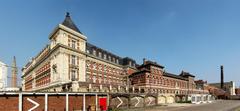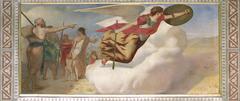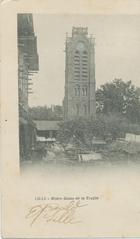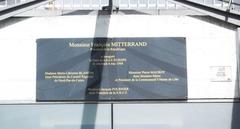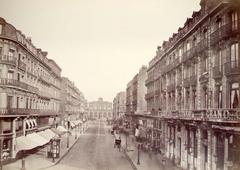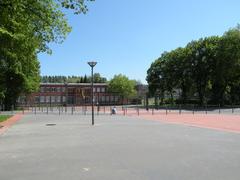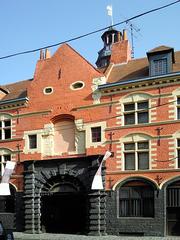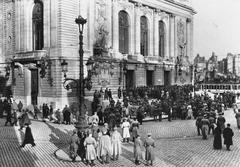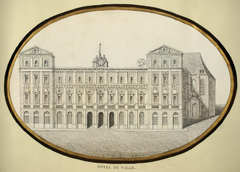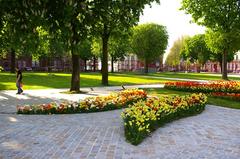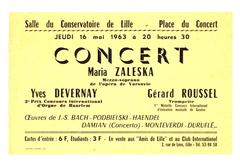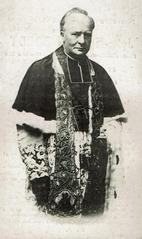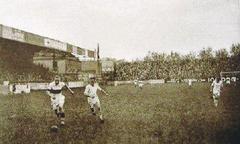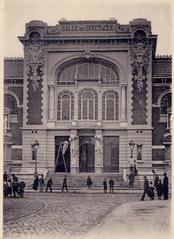
Synagogue De Lille: Visiting Hours, Tickets, and Historical Significance in Lille, France
Date: 04/07/2025
Introduction
The Synagogue De Lille, centrally located in the heart of Lille, France, is a profound symbol of Jewish heritage, resilience, and architectural splendor. Established in 1891 during a period of Jewish community re-establishment, it has served as both a vibrant place of worship and a significant cultural landmark. Its striking Romano-Byzantine style, unique cast-iron pillars, and ornate stained-glass windows reflect not only religious traditions but also the industrial and multicultural history of Lille. Surviving the devastation of World War II and recently restored to its original grandeur, the synagogue stands as a beacon of continuity and renewal for the city’s Jewish community and visitors alike.
This comprehensive guide covers the synagogue’s rich history, architectural features, visitor information—including hours, tickets, tours—and practical tips for anyone wishing to explore one of Lille’s most treasured historical sites. Whether you are a history enthusiast, architecture lover, or cultural traveler, the Synagogue De Lille offers a unique window into northern France’s Jewish legacy. For additional details, see JGuide Europe, Jewish Virtual Library, and Jewish Heritage Europe.
Table of Contents
- Discover the Synagogue De Lille: A Jewish Landmark
- Early Jewish Presence in Lille and the Nord Region
- 19th-Century Re-establishment and Growth
- Construction and Architectural Features
- Community Life and Notable Figures
- The Holocaust and Aftermath
- Contemporary Community and Role
- Visitor Information: Hours, Tickets, and Tips
- Architectural and Cultural Heritage
- FAQ
- Key Dates and Milestones
- Grande Synagogue de Lille: Historical and Cultural Significance
- Synagogue De Lille: Architecture and Visitor Guide
- Synagogue de Lille: Practical Visitor Guide
- Summary and Visitor Tips
- Official Sources and Further Reading
Discover the Synagogue De Lille: A Jewish Landmark
The Synagogue De Lille is not only a place of worship but also a testament to the enduring Jewish presence in Lille. As a central hub for community, culture, and education, it represents both the challenges and triumphs of the Jewish community throughout centuries of change.
Early Jewish Presence in Lille and the Nord Region
Jewish history in Lille and the wider Nord region dates back to the Middle Ages, evidenced by the existence of Jewish quarters (“rues des Juifs”) and a documented settlement in 1023, when the Count of Baudouin permitted Jews from Lorraine to settle in towns like Hautmont and Cambrai (JGuide Europe). However, the expulsion of Jews from France in 1394 led to the disappearance of formal Jewish communities in the region for several centuries.
19th-Century Re-establishment and Growth
Jewish life in Lille was revived around the French Revolution, with the arrival of Alsatian Jews marking a new era. By 1809, census data recorded 166 Jews in Nord and 63 in Pas-de-Calais (JGuide Europe). The establishment of a chief rabbinate in 1872 under Rabbi Benjamin Lippmann signaled growing communal importance, leading up to the synagogue’s inauguration in 1891 (Jewish Virtual Library).
Construction and Architectural Features
Designed by Théophile-Albert Hannotin and opened in 1891, the synagogue is a prime example of Romano-Byzantine architecture, with a 17-meter nave supported by twelve cast-iron pillars symbolizing the twelve tribes of Israel. Its monumental facade features a large stained-glass window, sculpted Tablets of the Law, and a Hebrew-French inscription from Genesis 28:17: “This is none other than the house of the Lord, and this is the gate of heaven” (Jewish Heritage Europe). Stork motifs on the facade pay homage to the Alsatian roots of many congregants.
Listed as a Monument Historique in 1984, the synagogue underwent a major restoration between 2019 and 2022, funded by the City of Lille and other partners, restoring both the exterior and the intricate stained glass (France 3 Régions).
Community Life and Notable Figures
By the early 20th century, Lille’s Jewish community included over 500 families, with additional vibrant communities in nearby towns. Noteworthy figures such as Armand Lipman, son of Grand Rabbi Benjamin Lipman, contributed to Jewish intellectual and civic life within Lille and beyond.
The Holocaust and Aftermath
World War II was a period of profound tragedy. Under German occupation, many Jews in Lille were deported, including Rabbi Léon Berman and his family. Of the 461 Jews deported from the Nord region, only 125 returned (Jewish Virtual Library). After the war, survivors and new arrivals, including Sephardic Jews from North Africa in the 1960s, rebuilt the community.
Contemporary Community and Role
By 1987, Lille’s Jewish population had grown to around 2,800 and today numbers about 3,000 (Jewish Virtual Library). The synagogue remains the heart of Jewish religious, cultural, and social life, hosting services, educational programs, and interfaith events. Its continued vitality is a testament to the resilience and adaptability of the community (JGuide Europe).
Visitor Information: Hours, Tickets, and Tips
Visiting Hours
- Weekdays: Monday–Friday, 10:00 AM – 12:30 PM and 2:00 PM – 5:00 PM
- Closed: Saturdays, Jewish holidays, and during religious services
- Recommendation: Confirm hours by contacting the synagogue or checking Lille Tourism.
Tickets and Tours
- Admission: Free (donations welcome); guided tours by appointment, especially during European Heritage Days and cultural events
- Group Visits: Book in advance through the synagogue or tourist office
Accessibility
- Wheelchair access: Available at the main entrance
- Location: 5 Rue Auguste Angellier, Lille; near République - Beaux-Arts metro station
Security
- Expect bag and personal checks; avoid bringing large bags or restricted items (PaulMarina).
Dress Code and Conduct
- Modest attire required; men are encouraged to wear a kippah (provided on site if needed)
- Silence and decorum are expected; photography only with permission
- Avoid visiting during Shabbat or major Jewish holidays unless attending a service
Architectural and Cultural Heritage
The synagogue’s Romano-Byzantine features—including cast-iron pillars and stained-glass windows—symbolize both Jewish tradition and Lille’s industrial legacy. Recent restoration revealed hidden stencils and friezes, further enhancing its historic value (Jewish Heritage Europe). Its survival through WWII, when it was used for storage rather than destroyed, preserves a rare continuity among French synagogues (Wikipedia).
Frequently Asked Questions (FAQ)
Q: What are the Synagogue De Lille’s visiting hours?
A: Monday to Friday, 10:00 AM – 12:30 PM and 2:00 PM – 5:00 PM; closed on Saturdays and Jewish holidays.
Q: Is there an entrance fee?
A: Admission is free; donations are appreciated.
Q: Are guided tours available?
A: Yes, by appointment and during special events.
Q: Is the synagogue accessible for visitors with disabilities?
A: Yes, there is wheelchair access.
Q: Can I visit during Jewish holidays?
A: The synagogue is closed during Jewish holidays and Shabbat except for worshippers.
Key Dates and Milestones
- 1023: Jewish settlement authorized in the Nord region
- 1394: Expulsion of Jews from France
- Late 18th century: Jewish community re-established in Lille
- 1809: Census records 166 Jews in Nord
- 1872: Lille becomes seat of a chief rabbinate
- 1891: Synagogue inaugurated
- 1932: Over 500 Jewish families in Lille
- 1942–1944: Wartime deportations and tragedy
- Post-1945: Community rebuilding
- 1987: Population reaches 2,800
- Present: Community of approximately 3,000
Grande Synagogue de Lille: Historical and Cultural Significance
The Grande Synagogue de Lille, officially classified as a Monument Historique, is the oldest and most important Jewish house of worship in northern France (France 3 Régions). Its architecture, interior murals, and restored furnishings symbolize Jewish resilience and integration into French civic life. Restoration completed in 2022 revealed hidden artistic elements, further underscoring its cultural value.
As the sole synagogue in Lille, it is the center of all Jewish religious, educational, and social activities—including religious ceremonies, cultural events, and interfaith dialogue. Its municipal ownership and accessibility to non-Jewish visitors foster mutual understanding and civic engagement.
Visiting Essentials
- Tours: Book in advance, especially during heritage events
- Accessibility: Upgraded facilities for mobility-impaired visitors
- Nearby Attractions: Palais des Beaux-Arts, Grand Place, and Lille’s Old Town
For details, see France 3 Régions.
Synagogue De Lille: Architecture and Visitor Guide
Blending Romanesque Revival and Byzantine Revival styles, the synagogue was designed by Théophile-Albert Hannotin and inaugurated in 1891. Its monumental stone facade features a large stained glass window, stork motifs, and the Tablets of the Law, with inscriptions in Hebrew and French (Wikipedia; France-Voyage).
The interior is defined by a single nave with cast-iron pillars (representing the twelve tribes of Israel), original period furnishings, and intricate stained glass. Surviving WWII largely intact, the building is recognized for both its architectural and historical continuity.
Synagogue de Lille: Practical Visitor Guide
- Address: 5 Rue Auguste Angellier, Lille
- Contact: +33 3 20 52 41 59 (JGuide Europe)
- Hours: Vary; always confirm in advance, especially outside regular weekdays
- Tickets: Free admission; fees may apply for guided tours
- Security: Bag inspections and personal screening are standard (PaulMarina)
- Dress Code: Modest attire; men should wear a kippah or hat
- Accessibility: Step-free entrance; inquire regarding restroom and facilities
- Etiquette: Silence, respect for services, and permission before photography
For tips on etiquette and planning, see PaulMarina.
Summary and Visitor Tips
The Synagogue De Lille is a living monument to Jewish endurance and cultural richness. Its architectural splendor, historical significance, and active role in community life make it an essential stop on any Lille itinerary. Plan your visit by confirming hours, respecting community customs, and considering a guided tour for deeper insights.
Combine your visit with other historical sites in Lille, such as the Palais des Beaux-Arts and Old Town. Download the Audiala app for guided audio tours and stay informed about cultural events and restoration projects.
For more information:
Official Sources and Further Reading
- JGuide Europe: Synagogue De Lille—History and Visitor Guide
- France 3 Régions: Grande Synagogue de Lille Restoration and History
- Jewish Heritage Europe: Synagogue De Lille Architecture and Restoration
- JGuide Europe: Synagogue de Lille Visitor Information
- Lille Tourism Official Website
- Jewish Virtual Library: Lille
- PaulMarina: Synagogue Etiquette
- France-Voyage: Synagogue Lille
- Wikipedia: Synagogue de Lille


